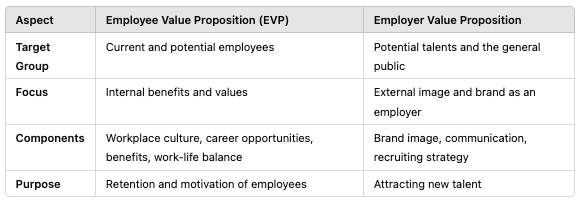Employee value proposition
The employee value proposition describes the unique promise that a company offers its existing and potential employees.
The employee value proposition is the “why” that motivates and distinguishes the company as an employer.

It encompasses all the benefits, values and cultural characteristics that a company offers and answers the question:
Why should talented people want to work here?
A convincing EVP takes the following elements into account:
- Workplace culture: Values, atmosphere and way of working in the company.
- Career opportunities: Advancement and development opportunities open to employees.
- Remuneration and benefits: Financial and non-financial incentives, such as salary, bonuses, additional benefits or flexible working models.
- Work-life balance: Flexibility and opportunities to reconcile work and private life.
- Meaning and belonging: The meaning and impact of work in the context of larger goals and identification with the company.
A clearly defined employee value proposition helps companies to retain employees in the long term, as it makes it tangible what makes working for the company special.
It creates a basis for commitment and satisfaction, which ultimately also increases productivity.
Employer value proposition
The employer value proposition, on the other hand, focuses on how the company is perceived as an employer – primarily externally, but also internally.
It is about the overall image and the message that the company wants to convey in the market.
The employer value proposition is the promise to potential talent and employees that is filled out and kept by the employee value proposition.
It serves as the basis for employer branding in order to stand out from other employers and be attractive to the target group.
Some key aspects of the employer value proposition are
- Brand image: the values and mission statement that the company embodies and communicates to the outside world.
- Communication: How and through which channels the company communicates its values and culture to potential applicants.
- Recruiting strategies: The approach, approach channels and the type of message the company sends to talent.
- Consistency of the message: The employer value proposition should be authentic and consistent across all communication channels in order to create trust.
In contrast to the employee value proposition, which describes an internal offer, the employer value proposition is the image that companies create of themselves in order to be perceived as an ideal employer in the external talent market.
Differences between Employee Value Proposition and Employer Value Proposition
To summarize, the employee value proposition is the promise that a company actually offers its employees, while the employer value proposition is the message that the company sends to the outside world in order to be perceived as an attractive employer.

How do companies use both concepts?
A clear employee value proposition forms the basis for a strong employer value proposition.
The two concepts should be interlinked:
The benefits and promises of the Employee Value Proposition should be communicated authentically and consistently to the outside world so that the Employer Value Proposition is credible.
Companies that achieve this build trust and increase the likelihood that the talent they attract will stay in the long term.
A good Employer Value Proposition attracts talent, a convincing Employee Value Proposition ensures that this talent stays.
By coordinating internal offers and external communication, companies strengthen their employer brand in the long term.
Conclusion
While the employee value proposition is the authentic value proposition to employees, the employer value proposition acts as the image that is carried to the outside world.
Both concepts work together to position the company as an attractive employer and thus attract and retain the best talent in the long term.
Companies that align their internal EVP and external employer value proposition create a strong employer brand that not only attracts employees, but also motivates and retains them in the long term.



